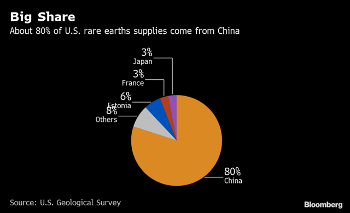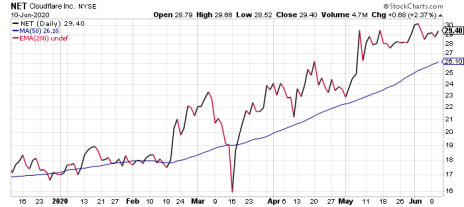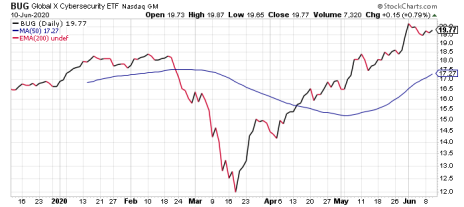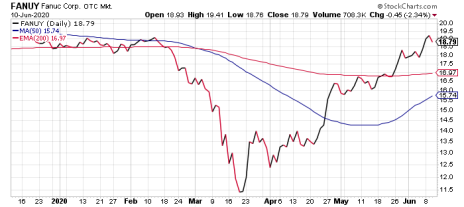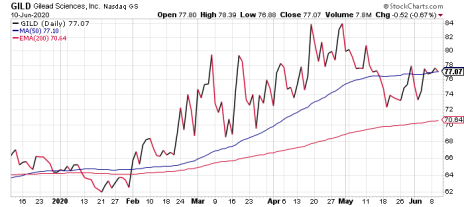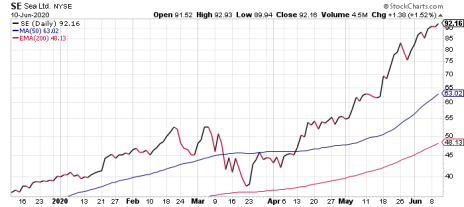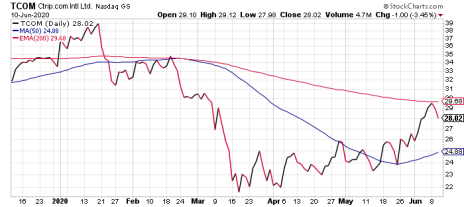Our emerging markets signal (EEM) is decisively positive after relative outperformance by emerging market stocks over the last couple of weeks. The Fed signals that rates will likely stay near zero through 2022 and the Fed chairman promised to “run stimulus programs forcefully, proactively and aggressively for years, if necessary.”
Although jobs numbers surprised on the upside, it looks like the market is shrugging off that GDP will gap down about 6% in 2020 and the federal budget deficit reached $400 billion for one month – May!
Today, we have a new recommendation that is at the heart of technology and hedges the growing tension and risk in Asia.
Cabot Global Stocks Explorer 713
[premium_html_toc post_id="207490"]
Emerging Markets Catch Up
It was a rather quiet week for the Explorer portfolio as Sea Limited (SE) had another good week, going from 87 to 92 after rising 44% in May. The Singapore market showed some strength and DBS Bank (DBSDY) was up 6%, as was Japan’s Fanuc (FANUY). All other positions were relatively quiet. Former holding Luckin Coffee (LK) made a strong move this week and then fell back over the last couple of days to around 3.5.
At the beginning of 2020, I was anticipating a resurgence in emerging markets, but the upheaval over the past few months has thrown all predictions to the wind.
Emerging markets, which lagged big tech and big data in coming off March lows, have snapped back recently and our emerging markets timer (EEM) is now decisively positive. That said, emerging markets are a bit like biotech stocks – either hot or cold. Between 2003 and 2007, for example, emerging markets were the best asset class in the world, with consecutive annual returns of 55.8%, 25.6%, 34.0%, 32.2% and 39.4% over those five years. Let’s hope a similar run is in store in the years ahead.
An Overlooked Risk
To quote legendary investor Peter Lynch, “Far more money has been lost by investors preparing for corrections, or trying to anticipate corrections, than has been lost in corrections themselves.”
This has certainly been true since the market hit its lows in March. But sometimes, amid all the noise of the pandemic, economic upheaval, the looming U.S. presidential election and political protests, a risk factor can be overlooked.
This may well be the rising tension in the South China Sea and East China Sea as well as in Hong Kong and Taiwan against the backdrop of the growing U.S.-China rivalry.
This week, the U.S. deployed two aircraft carrier strike groups as China’s military steps up its activity in the region. The deployments of the USS Ronald Reagan and USS Nimitz boosted the U.S. naval presence in an area marked by tension with China over territory.
Taiwan’s defense ministry said Tuesday that several Chinese jet fighters briefly crossed into Taiwan’s air defense identification zone, an area adjacent to coastlines considered sensitive for national security. Japan reported a return trip by a Chinese aircraft carrier and its strike group of smaller military vessels through Japan’s southern island string for the first time in April.
Below is a map from the Center for Strategic & International Studies that highlights the conflicting territorial claims.
The commander of the U.S. Pacific Fleet, Admiral John Aquilino, said last week: “The Chinese Communist Party must end its pattern of bullying Southeast Asians out of offshore oil, gas, and fisheries.” Meanwhile, China’s foreign ministry recently issued a statement that “China will always resolutely safeguard its sovereignty, security and development interests, no matter what, no matter when.”
The U.S. has sent three naval ships on patrols near oil-and-gas operations off Malaysia’s coast in recent days, a show of support for the Southeast Asian nation whose offshore explorations in the South China Sea have faced pressure from China. The littoral combat ship USS Gabrielle Giffords sailed to this contested area after two other U.S. naval vessels patrolled there last week. This ramping up of activity included exercises in the South China Sea last month that involved three American warships and an Australian navy frigate.
Today’s new recommendation seeks to hedge this rising risk.
New Explorer Recommendation
Van Eck Rare Earths/Strategic Metals (REMX)
One of my favorite books is Daniel Yergin’s riveting tale of the major role oil played in the 20th century: The Prize: The Epic Quest for Oil, Money & Power. Oil not only powered the economy, it also played a pivotal role in the century’s statecraft. The following sentence in the book’s prologue really caught my eye.
“As we look toward the 21st century, it is clear that mastery will certainly come as much from a computer chip as from a barrel of oil.”
But what’s behind the computer chip and advanced technology that forms the backbone of so much that we take for granted in modern life?
The answer is critical, rare, strategic metals and, in particular, an important subset called rare earths. These vital ingredients are critical to economic growth and advancement of technology.
They are also invisibly intertwined with national economic strategies, geopolitics, wealth and power. Rare earths and rare metals, often called technology metals, have many commercial and military applications.
Like yeast in bread, they are required in small quantities in all sorts of products, from cell phones to advanced weapons systems, aircraft engines, robots and hybrid batteries.
At least a dozen of them power your cell phone. This is a key reason why most iPhones are largely assembled in China.
They are essential in emerging technologies such as robots, lasers, night vision applications, advanced drones and missiles, radar, and aircraft engine turbines. Some specific military examples are the F-35 Fighter, which contains 920 pounds of rare earths and rare metals; the Aegis Destroyer, which contains 5,200 pounds; and a nuclear submarine, which requires 9,300 pounds. But rare earths aren’t just for military use. Even each Toyota Prius uses 25 pounds of the stuff.
In clean energy, rare metals and rare earths are widely used in wind turbine motors and as a key ingredient in large grid electricity storage used by utilities.
Rare earth elements are very difficult, time consuming and expensive to extract and process. In addition, the refining of rare earths and many rare metals is unfriendly to the environment. It would be very difficult to get a permit to produce them in America.
The real value of these materials is their unique magnetic and electrochemical properties, which improve efficiency, performance, speed and durability for numerous technologies. This allows for miniaturization and much lighter, stronger, resilient, and efficient components.
One example is Neodymium, which is essential in making permanent super magnets.
A lot of media attention regarding electric vehicles (EVs) has been centered on key ingredients in the battery such as cobalt and lithium. But Neodymium-powered super permanent magnets are essential to EV motors.
Since the 1990s, China has become the Saudi Arabia of rare earths as the country’s favorable geology, low-cost labor and lax environmental standards allowed it to produce about 85% the world’s production.
After a long period of weak pricing and being off the front page, rare earths are now back in the news with prices and headlines on an upward trajectory.
VanEck Vectors Rare Earth/Strategic Metals (REMX) is an exchange-traded fund (ETF) launched in 2010. It is fairly concentrated with 21 holdings; the top 10 holdings represent 61% of assets and more than half of the holdings are Chinese companies.
REMX surged 82% in 2017, pulled back 45% in 2018 – returning to its 2017 low, and now it is in an uptrend again.
The electric vehicle revolution alone could power this ETF forward but the U.S.-China trade conflict could really launch this recommendation into space.
Forced into a corner, China could cut back on the amount of rare earths it allows into global markets, specifically to American or Japanese companies. This would send REMX soaring.
REMX is also a great hedge on U.S.-China rising tensions and political risk.
This is an excellent time to build a half position. BUY A HALF
Model Portfolio
| Stock | Price Bought | Date Bought | Price 6/10/20 | Profit | Rating |
| Alibaba (BABA) | 102 | 1/27/17 | 224 | 119% | Watch |
| Cloudflare, Inc. (NET) | 24 | 4/30/20 | 29 | 23% | Buy a Half |
| DBS Bank (DBSDY) | 50 | 4/2/20 | 67 | 34% | Buy a Half |
| Fanuc (FANUY) | 13 | 4/16/20 | 19 | 40% | Buy a Half |
| Gilead Sciences (GILD) | 76 | 5/28/20 | 76 | 1% | Buy a Half |
| Global X Cybersecurity ETF (BUG) | 17 | 4/30/20 | 20 | 17% | Buy a Half |
| Sea Limited (SE) | 15 | 2/8/19 | 92 | 520% | Hold Half |
| Trip.com Group (TCOM) | 23 | 5/14/20 | 28 | 22% | Buy a Half |
| Van Eck Rare Earths (REMX) | New | — | 37 | — | Buy a Half |
| Virgin Galactic (SPCE) | 7.34 | 12/5/19 | 16 | 120% | Buy |
Portfolio Changes
None
Updates
Cloudflare (NET) shares rose 23% in May but the stock was up only marginally this week and seems to be facing resistance around 30.
This aggressive cybersecurity recommendation went public last year. The company is growing fast and appears to be gaining market share and some analysts expect its revenue to double by 2022. If you have not yet invested in NET, I suggest you do so and consider pairing it with the below more conservative cybersecurity play, BUG... BUY A HALF
Global X Cybersecurity ETF (BUG), a basket of cybersecurity stocks of companies that prevent cyber attacks, was flat as a pancake this week. This is a play on concerns over online security as cybercrime has reached an all-time high, with damages from these activities expected to cost $6 trillion annually by 2021.
This ETF has 29 holdings and the top 10 stocks represent roughly 60% of the total market value. Seventy-four percent of the companies are incorporated in America followed by 13% in Israel and 8% in Japan. This ETF can be seen as a more conservative play on cybersecurity and can be paired with the above more aggressive Cloudfare (NET) play. BUY A HALF
DBS Bank (DBSDY) shares have leapt from 57 to 67 over the past two weeks as the Singapore market has broken out of a period of underperformance. DBS, with a dividend yield of 5.6%, is still trading below its January high of 78.
Digital banking is also a profitable trend since DBS’s digital customers making up more than 50% of its retail and small business base in Singapore and Hong Kong, up 25% in the last two years. DBS is one of the largest banks in Southeast Asia with a presence in 18 high-growth markets across Greater China, Southeast Asia, and South Asia/India.
I encourage you to aggressively buy DBS at these levels. BUY A HALF
Fanuc (FANUY) shares posted another 6% gain this week as it closes in on its 2020 high of 19.
Fanuc is the world’s leading manufacturer of computerized numerical control (CNC) devices that are used in machine tools and also serve as the “brains” of industrial robots used in manufacturing all sorts of high value products, including other robots.
Fanuc offers investors a balance sheet with zero debt and $7 billion in cash. Profit margins are impressive and Fanuc bought back more than 70 million shares recently. In short, Fanuc is a high-quality play on a growth trend. I encourage you to buy this conservative robot play if you have not already done so. BUY A HALF
Gilead Sciences (GILD), the most recent addition to the Explorer portfolio, moved from 74 to 77 this past week.
While the focus right now is on remdesivir, which has received emergency approval by the FDA to treat severely ill Covid-19 patients, Gilead Sciences is one of the leaders in the market for HIV treatment, and sales of the company’s HIV products continue to perform well. During the first quarter, sales of Gilead’s HIV products were $4.1 billion, up from the $3.6 billion recorded during the prior-year quarter. In addition, there is filgotinib, a potential treatment for rheumatoid arthritis and other conditions such as Crohn’s disease that Gilead submitted to the FDA in December 2019.
SVB Leerink analyst Geoffrey Porges has upgraded Gilead to outperform, stating that sales of remdesivir could reach $2 billion this year and $7.7 billion in 2022.
If you haven’t yet purchased shares, I encourage you to build a half position. BUY A HALF
Sea Limited (SE) shares, up 44% in May, continue to surge, zooming from 71 to 92 in the last two weeks, and are now up more than 110% so far in 2020.
While e-commerce and gaming are Sea’s biggest revenue contributors by a large margin, SeaMoney is one of the fastest-growing digital financial services networks in Southeast Asia. Its offerings include e-wallet services, payment processing, micro-lending, and related digital financial services. These services and products are available in various markets across Southeast Asia under AirPay, ShopeePay, Shopee PayLater, and other related brands.
We are in a strong position, having sold half our position a month ago at 55 for gain of 310%. Sea is now a hold but we will be buyers if the stock pulls back. If you have not already sold half your shares, I strongly suggest you do so now. SELL HALF YOUR POSITION - HOLD THE BALANCE
Trip.com (TCOM) shares had a quiet week, with no news after making a nice move late last week. The company is a China travel service provider that specializes in ticketing, reservations, and tours as well as aggregating hotel and transport information. Trip began 2020 with a strong tailwind as its fourth-quarter 2019 net income soared from $161.7 million to $1 billion.
TCOM has enormous reach and scale in China as well as overseas, providing reservation services for more than 1.4 million hotel and hostel properties, and more than 1.2 million vacation rental properties around the world.
This is an aggressive idea with considerable uncertainty but I believe there is enough evidence of a rebound in domestic travel to warrant a half position. BUY A HALF
Virgin Galactic (SPCE) shares were flat this week after increasing 16% in the prior week and I upgraded the stock from buy a half to buy a full position. I recommended selling half your shares a few weeks back for a 146% gain so we are now in a strong position to ride this compelling story forward.
Galactic plans to send groups of paying customers on brief flights to the edge of space. Perhaps even more important to its future than space tourism is its plan to launch point-to-point hypersonic flights. SPCE still plans to make its first commercial space-tourism flight this year, and took a step forward with two test flights from its New Mexico spaceport in the first quarter.
If you have not yet bought more shares in this compelling story, I encourage you to do so. BUY A FULL
Watch List
Alibaba (BABA) shares went from 218 to 222 this week as Oppenheimer sees e-commerce sales rebounding nicely in May in the range of 25% to 40%. Given the headwinds of potential delisting, rising U.S.-China tensions and the fact that this company has gotten so big, sizable upside potential is limited and the stock has a consensus six-month target of around 250. Below is a chart outlining how 93% of BABA’s revenue comes from China.
The next Cabot Global Stocks Explorer issue will be published on June 25, 2020.
Cabot Wealth Network
Publishing independent investment advice since 1970.
CEO & Chief Investment Strategist: Timothy Lutts
President & Publisher: Ed Coburn
176 North Street, PO Box 2049, Salem, MA 01970 USA
800-326-8826 | support@cabotwealth.com | CabotWealth.com
Copyright © 2020. All rights reserved. Copying or electronic transmission of this information is a violation of copyright law. For the protection of our subscribers, copyright violations will result in immediate termination of all subscriptions without refund. No Conflicts: Cabot Wealth Network exists to serve you, our readers. We derive 100% of our revenue, or close to it, from selling subscriptions to its publications. Neither Cabot Wealth Network nor our employees are compensated in any way by the companies whose stocks we recommend or providers of associated financial services. Disclaimer: Sources of information are believed to be reliable but they are not guaranteed to be complete or error-free. Recommendations, opinions or suggestions are given with the understanding that subscribers acting on information assume all risks involved. Buy/Sell Recommendations: All recommendations are made in regular issues or email alerts or updates and posted on the private subscriber web page. Performance: The performance of this portfolio is determined using the midpoint of the high and low on the day following the recommendation. Cabot’s policy is to sell any stock that shows a loss of 20% in a bull market or 15% in a bear market from the original purchase price, calculated using the current closing price. Subscribers should apply loss limits based on their own personal purchase prices.


